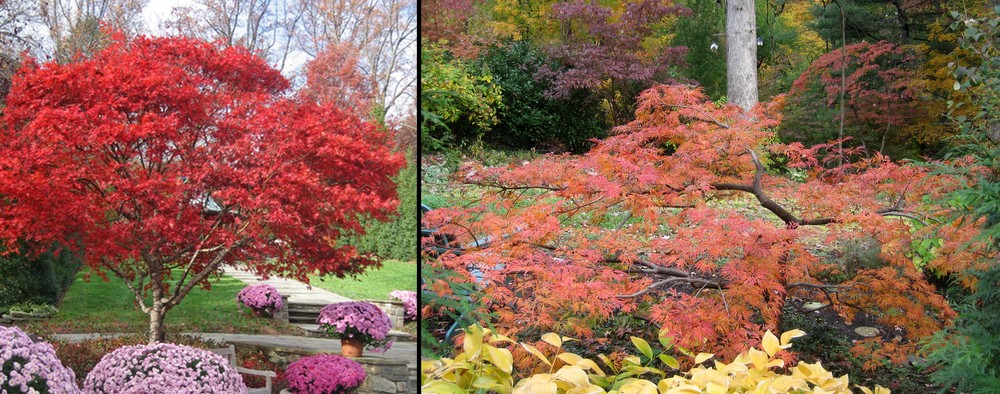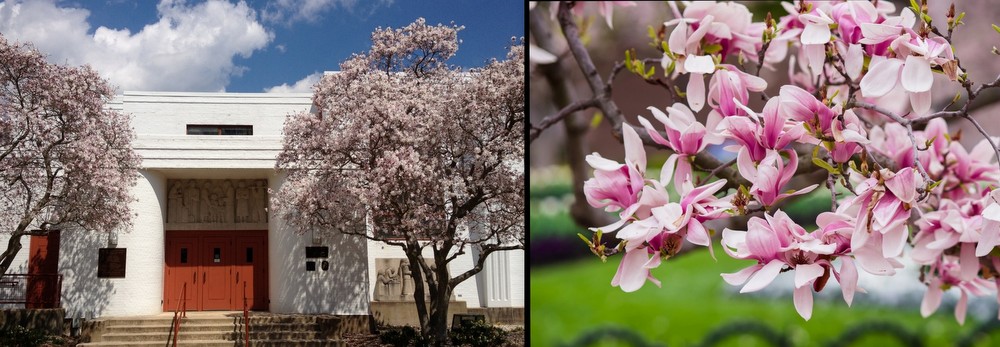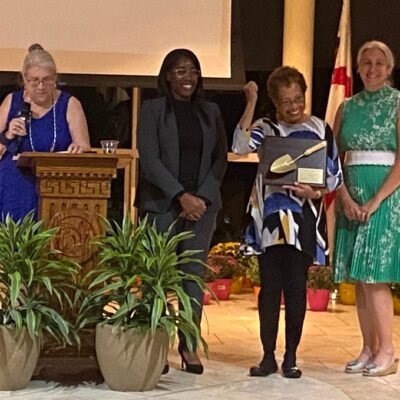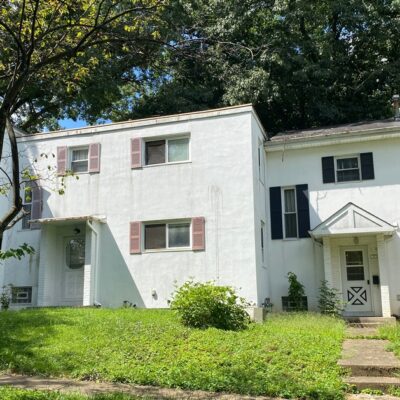
The original large shade trees planted in the town of Greenbelt are now 80 years old, close to or beyond their expected lifetime. To take their place we need lots more trees to be planted but for understandable reasons, residents are reluctant to plant trees like oaks near their homes.
Which is why it’s time to tout the glories of small flowering trees for small-yard owners in Greenbelt, especially the townhouse yards of GHI. These smaller trees won’t pose a danger to your house, and dealing with their dropped leaves in the fall is no big deal. In addition to flowering shrubs, these trees form the backbone of a beautiful, lush and wildlife-friendly garden, no matter how reduced the square footage.
I’ve reviewed the many lists online and culled from them my favorites for small gardens in our area. I’ve also added helpful comments by John Shearin, tree and shrub manager at Behnkes Nurseries.
My qualifications on the subject? No formal schooling in woody plants, but I’ve gardened in this region for 40+ years and also coached many others in choosing plants that do well here. My Master Gardener certification sounds impressive but is really a misnomer because it doesn’t guarantee that I know a thing about gardening. Really.
When and How to Plant and then Keep Alive
- When: While fall is the best time to plant trees, I say plant them whenever you can find them, as long as you can water them regularly for their first few weeks in the ground. Behnkes has most of these trees in stock now, with more arriving soon.
- How: Click here to watch the very best videos on planting trees and shrubs.
- Keep Alive: The #1 way that customers kill new plants is by watering wrong – too little, too much or the wrong way. Click here to watch the best videos about watering.
Dogwood (Cornus florida)
The best-known small flowering tree in our area is probably our native dogwood. Because in recent years it’s been plagued by disease, buyers are cautioned to look for disease-resistant varieties, like the Appalachian and Cherokee series. Hybrids with the Kousa dogwood (below) are also increasingly popular for their disease-resistance.
Kousa Dogwood (Cornus kousa var chimensis)
This Asian dogwood, which blooms a couple of weeks later than Cornus florida, is about as tall but with a wider, fuller shape. It’s quite disease-resistant and can also take more sun than our native dogwood.. Learn more.
Redbud (Cercis canadensis)
The redbud is another tree native to our region, and its benefits for wildlife are well known. They weirdly grow their spring blooms directly on the branches, after which the fabulous heart-shaped leaves appear. I’ve planted two in my tiny back yard, one with medium green leaves and the other – the awesome ‘Rising Sun’ shown on the right – with chartreuse-to-yellow foliage. It was featured on PBS as a Plant of the Week – click here. One variety that John Shearin especially likes for small spots is the “Oklahoma” variety. Redbuds are fast-growers.
Serviceberry (Amalanchier arborea)
Another native plant, this one especially popular for its gorgeous fall foliage. Some may consider it too messy – those dropping berries, ya know – but the berries are delicious! John tells me they taste just like blueberries.
Japanese maples (Acer palmatum)
Japanese maples come in an astounding variety of leaf types, growth habits, colors and sizes. For example, some are vase-shaped while others are low and horizontal, like the orange example above. Japanese maples are slow-growing (and therefore on the pricier side) but very low-maintenance.
Southern and Sweetbay Magnolia
I’ve coveted but never grown Magnolias myself, so I consulted with John at Behnkes, who recommends two types. Some types can reach as tall as 60 feet, so choose carefully.
Southern Magnolia (Magnolia grandiflora) is evergreen and native to the Southeastern U.S. Two smaller varieties are ‘Little Gem” and “Teddy Bear.”
Sweetbay Magnolia (Magnolia virginiana) is semi-evergreen, dropping about half its leaves in the fall. Grow to 10–20′ tall with a spread of 10–20′ at maturity.
Crape myrtle (Lagerstroemia)

Crape myrtles are widespread in Greenbelt (some would say too much so), because they do so well here, even in the toughest of spots, like the parking lot at Roosevelt Center. They also come in a wide variety of sizes from a compact shrub to a 30-foot tree, with flowers ranging from white to fuchsia, and with an “exfoliating” bark that offers winter contrast. behnkes has a large selection right now, while you can see the flower color.
Every garden writer’s caution about crape myrtles is about bad pruning practices, usually called “Crape murder.” That’s the common practice of chopping off the tops of the tree because its flowers are too high up to be easily seen. Avoid this problem in the first place by choosing plants whose blooms are naturally low enough to be seen, so you won’t need to top if off every year. Some choices recommended in Southern Living Magazine are ‘Acoma’ (white flowers, 6-10 feet tall), ‘Early Bird’ (white or purple, 6-8 feet), ‘Siren Red’ (dark red, 8-10 feet tall), ‘Velma’s Royal Delight’ (rich purple, 4-6 feet), ‘Zuni’ (lavender, 6-10 feet), ‘Pink Velour’ (neon pink, 10-12 feet), and ‘Tonto’ (red, 10-12 feet). Or just read the label carefully before buying, no matter how much you love the color.
Japanese Snowbell (Styrax japonicus)
My next-door neighbor has a graceful Japanese Snowbell that looks great with literally no effort on her part, so I’m a fan. John at Behnkes is also a fan and laments that Japanese Snowbells are underused. They grow to approximately 20 feet tall and wide. Learn more.
3 More Shearin Faves: Franklin Tree (Franklinia alatamaha)
Also underused in John’s opinion is the Franklin tree, which is native to Georgia. Learn more about Franklin trees. (Photo credit.)
Standard Ninebark (Physocarpus opulifolius)
I’m a HUGE fan of the native shrub Ninebark but had never seen it grown as a “standard,” which John recommends as a small tree-like plant. (Standard means it was pruned early on to grow upright.) Here’s John Shearin with two examples of standard Ninebarks at Behnkes this week. Learn more about Ninebarks.
Standard Panicle hydrangea (Hydrangea paniculata)
 Another shrub that can be used as a small tree is a panicle hydrangea that’s been pruned upright like a tree. The label for this one says it grows to just 6-8 feet tall and wide. Unlike the more common and earlier-blooming Hydrangea macrophylla, the late-blooming panicle-type hydrangea can take full sun and is quite drought-tolerant after its first season in the ground.
Another shrub that can be used as a small tree is a panicle hydrangea that’s been pruned upright like a tree. The label for this one says it grows to just 6-8 feet tall and wide. Unlike the more common and earlier-blooming Hydrangea macrophylla, the late-blooming panicle-type hydrangea can take full sun and is quite drought-tolerant after its first season in the ground.
Learn more about panicle hydrangaes.
Not Recommended, and Why
- Crabapple, which I omitted from this list because they’re too messy for most small yards. Its dropped apples aren’t even edible.
- Ornamental cherries like the famous ‘Kwanzan’ and ‘Yoshino’ varieties seen around the Tidal Basin. They’re pretty, but disease-prone, especially in humid climates like ours.
- Bradford Pears! Seriously, just say no to these National Arboretum-bred mistakes! Click here to find out why they’re “the worst tree ever.”




















Carol Reese
I’ll have to speak up for crabapples! Not only do some have truly tasty fruit (fantastic for jelly) but serve as food for birds and other wildlife. Be sure to research the many cultivars for disease resistance and ultimate size and form….and site where the dropping fruit won’t be vexing.
Jeanne Aller
Good idea! That way you have both evergreen and deciduous choices, and they’re all great trees.
Jeanne Aller
Love the article, great recommendations, and small space plants are very important now, so many people seem to be right-sizing. Question about the magnolia pictures, though – both look like magnolia x soulangeana to me (which is also a great smaller flowering tree) and not like the two native magnolias described. All 3 are great plants, but it just didn’t seem to match –
https://en.wikipedia.org/wiki/Magnolia_%C3%97_soulangeana
Susan Harris
Thanks for the photo ID and I think I’ll amend the post to include Saucer magnolia coz they’re small, too and gorgeous!
michele
Great article! I already have seven of these beauties in my small, city yard & we enjoy every one of them. We look forward to a small crop of the delicious serviceberries every June – those we get before the birds do! I’m looking for one more tree & I’m hoping I can use the Ben Franklin tree this time. These trees reward in so many ways: beautiful blooms, colorful (& rarely, edible) berries, autumn color & lots of bird activity. This year we have at least 8 different varieties of song birds nesting in our yard which we love watching ( they reduce mosquitoes, too). Thanks for the great recommendations!
S Stern
THANK YOU Susan! I was just wondering what GHI might be doing to start the next generation of trees for our common areas too. This is a great work you have contributed. I also appreciate the comment by Rachel about gum trees, since they seem to sprout up too easy (such as right beside where a large tree was just removed in common area : ( and wonder if anyone has a different opinion.
Susan Harris
Linus, dogwoods and redbuds can take shade, as can Japanese maples. Japanese Snowbells are fine in what could be called part-shade (less than half day sun).
Susan Harris
Katie, Viburnums are a great group of shrubs – totally. The best-performing one I’ve ever grown is the Doublefile, but it’s too big for my current yard. Now I have a Koreanspice Viburnum coz it stays small and smells amazing.
katie thompson
Great artilcle with very helpful pictures and descriptions! Thank you! How about viburnums? Nice variety, lovely shapes.
Linus
Any recommendations of additional small trees that can tolerate some shade?
Stewartia? Other Acers (e.g., Acer campestre)? Davidia involucrata?
Alix Stock
Excellent recommendations, Susan. You should hear Tom rant about Bradford pears.
Susan Harris
I just heard a folk singer do a song about trees, which she said she wrote after seeing a lot of dogwoods along Route 50 destroyed when they widened it. Well, I THINK the spring-flowering trees she was seeing weren’t dogwoods but Bradford pears, which are STILL lining the entire route!
rachel
oh and PLEEEEEEZE dont plant any more sweetgums, everyone! They are a menace anywhere except deep forest where they are beautiful. They have a great name too – liquidamber styraciflua
rachel
Great article! i like that you included pictures from greenbelt in the story. Near the library and crescent there is a lovely magnolia grandiflora. to me, those beautiful magnolias near the community center and at roosevelt center look like some kind of hybrid magnolia stellata. i have some magnolia virginiana in my yard and nearby and they are ok, but im not enthusiastic. their bloom is sweet and pretty but very sparse. the tallest one i have has a disconcerting habit of bending in half under heavy snow. i prefer the stellata types. There is a great styrax japonica between the library and the library parking lot and i have a really pretty styrax obassia in my yard – both great trees. crepe myrtles are awfully common, but they have such a long bloom season when we really need it. and even if the tree grows tall, they look lovely against the sky. i love them. i think they should be paired with hydrangea paniculata which bloom at the same time, have similar panicles but are mostly white.
Melissa Sites
Thanks so much for these recommendations. I’m planning to add a dogwood, redbud and sarvisberry to my backyard. Cross fingers!
I lol’d at the label of “worst tree ever” for the bradford pear. They have a pretty shape when mature, but, wow, do they have TERRIBLE POLLEN. They give both me and my son splitting headaches during the pollen season in the spring, and they are everywhere around Greenbelt!!! My only complaint about Greenbelt’s otherwise beautiful horticulture. 🙂